21 - Serous Membranes
Editors: Mills, Stacey E.
Title: Histology for Pathologists, 3rd Edition
Copyright 2007 Lippincott Williams & Wilkins
> Table of Contents > VII - Alimentary Tract > 27 - Anal Canal
function show_scrollbar() {}
27
Anal Canal
Claus Fenger
Introduction
The anal canal has a complex anatomy and histology, and new information still turns up with regard to its embryology, structure, function, and pathology. Unfortunately, much confusion continues about definitions and nomenclature. This chapter therefore includes a historical review and a discussion of the terms used for the different structures (1).
Historical Review
Anal diseases and their treatment are mentioned as far back as the Egyptian papyri (2). Nevertheless, there are few early descriptions of anal anatomy. Of note is Galenos (130 200 AD), who compared the anus to a laced-up purse (3). The first observations on the anal canal mucosa were published by Glisson (1597 1677) (4), who noted the anal valves. In 1717, Morgagni (5) mentioned the anal columns and included the now famous drawing in the Adversaria (Figure 27.1); in addition, it shows pronounced papillae. In 1727, Heister (6) described the smooth zone between the anal valves and the perianal skin; and, in 1732, Winsl w (7) described the semilunar lacunae between the valves and the bases of the anal columns.
The first exact microscopic description of the different epithelial zones in the anal canal was given by Robin and Cadiat in 1874 (8). The perianal apocrine glands were found by Gay in 1871 (9), and in 1878 Chiari introduced the theory of the anal sinus infection in the pathogenesis of anal fistulas (10). Hermann and Desfosses' (11) microscopic description of anal glands followed shortly afterward.
P.664
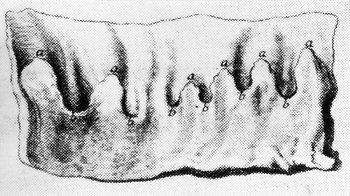 |
Figure 27.1 The anal canal as seen by Morgagni. Reprinted from: Morgagni GB. Adversaria anatomica omnia. Advers III Animadv. VI. Patavii, Italy: Josephus Cominus; 1717:10 11. |
In 1877 Hilton (12) introduced the term white line for the junction between the skin and the mucous membrane and corresponding to the linear interval between the internal and external sphincter muscle. In 1896, Stroud (13) introduced the term pecten for the smooth area between the anal valves and Hilton's white line. However, later investigators recommended that use of the term Hilton's white line should be discontinued because no anatomic feature identified it (14,15). Detailed macroscopic and stereomicroscopic investigations of surgical specimens of the anal canal have not shown any such structure (16,17).
The term anal canal was proposed by Symington in 1888 (18) for what had earlier been described as the third or perineal part of the rectum, that is, the part extending from the level of the pelvic floor backward and downward to the anal opening. This definition corresponds to the surgical anal canal, whereas the term anatomic anal canal has been used for the area between the line of anal valves and sinuses [dentate line (DL)] and the anal verge alone (Figure 27.2). The anal verge can be defined as the point (line) where the walls of the anal canal come in contact in their normal resting state (19).
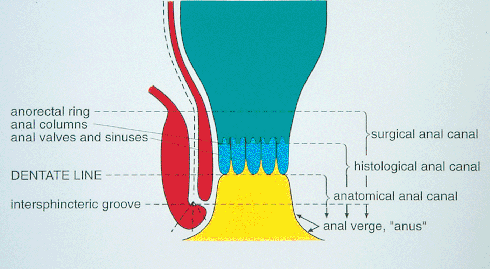 |
Figure 27.2 Schematic drawing of the anal canal showing the macroscopic landmarks. The surgical and anatomical anal canals have their lower border at the rather ill-defined anal verge, or anus. This point has sometimes been called the anal margin, whereas other authors have used this term for the same area as the anatomic anal canal. Hilton's white line was meant to be located at the intersphincteric groove; Stroud's pecten was the area between the dentate line and Hilton's line. The histologic anal canal begins at the irregular upper border of the anal transitional zone (compare to Figures 27.9,27.10,27.11,27.12,27.13). |
As to embryology, Tourneux in 1888 (20) and Retterer in 1890 (21) wrote that the cloacal membrane was divided into anal and urogenital membranes by a descending septum, thus giving basis for the often quoted but never illustrated delusion that the DL is the site of a former anal membrane.
Embryology
In the early embryo (Carnegie stage 13, crown-rump length 5 mm), the primitive urogenital sinus and anorectal canal are separated by the urorectal septum and open into a common cloaca, which is closed at its ventral surface by the cloacal plate. As the embryo grows and its caudal curvature decreases, the distance between the urorectal septum and the cloacal plate decreases, but these two structures never fuse.
Due to apoptosis, the dorsal part of the cloacal plate gradually becomes more like a membrane, which ruptures about 49 days postfertilization (Carnegie stage 19, crown-rump length 16 18 mm). Soon after, a secondary occlusion of the anorectal canal occurs as a result of cell adhesion and formation of an epithelial plug at the level of the anal orifice. Recanalization takes place at 30 to 35 mm crown-rump length, again due to apoptosis. The cloaca itself does not contribute to the formation of the anus or rectum (22,23). The characteristic epithelium of the anal transitional zone is present already in the thirteenth week (Figure 27.3).
The prevalence of anal anomalies in Europe is 4 per 10,000 births, and two-thirds occur together with other anomalies. Most of the isolated anomalies are atresias with or without fistula, and 90% of these are located below the levator ani. The etiology to anal atresia is still under discussion (24).
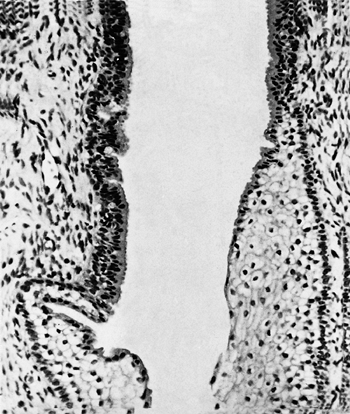 |
Figure 27.3 Longitudinal section through the middle of an anal canal in a 13-week-old fetus. Squamous epithelium is seen in the lower part; anal transitional zone with the characteristic epithelium is seen in the upper part (H&E). |
P.665
Nomenclature of the Anal Canal
It would seem natural to start with a definition of the anal canal; but, because there are several definitions and new terms are still introduced (25,26), a description of the anatomical landmarks and epithelial zones may be the best introduction to this never-ending discussion.
Official Terms
Official terms (27) for the structures seen on the anal canal surface include columnae anales, sinus anales, valvulae anales, linea pectinata, pecten analis, and linea anocutanea. However, the latter three terms are not generally accepted, and many synonyms have been used. Among the epithelial zones, only the anal transition(al) zone has got its own name.
When discussing anal nomenclature, one must always bear in mind that the terms anal columns, valves, and sinuses, and the line composed by the latter two structures are macroscopic landmarks. However, although they can be visualized by using macroscopic staining (28), the different zones in the anal canal are microscopic structures, and they do not correspond exactly to the macroscopic landmarks (16).
The most important macroscopic landmark is the line composed of the anal valves and sinuses and the bases of the anal columns (Figures 27.4,27.5). A list of names introduced for this line is given in Table 27.1 (1). Among these, the term dentate line is chosen by the International Union Against Cancer (UICC) and the World Health Organization (WHO) and is also widely used in textbooks (25,29,30,31,32). Anal valves and papillae are not present as often as reported in anatomy textbooks, and crypts and sinuses may be found over a larger area than compatible
P.666
with the definition of a line. Anorectal and anocutaneous refer to special definitions of the anal canal. When no valves, columns, or papillae are present, the line should be defined by the lowest sinuses visible.
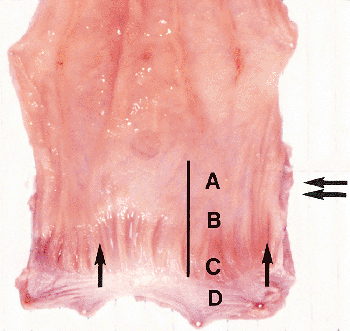 |
Figure 27.4 Autopsy specimen of the lower rectum and anal canal from an infant. The dentate line is composed of the bases of the well-defined anal columns. Only a narrow rim of perianal skin is at the bottom. The black vertical line indicates the extent of the anal canal, the single arrows the dentate line, and the double arrows the upper border of the anal transitional zone (formalin). (A, colorectal zone; B, anal transitional zone; C, squamous zone; D, perianal skin) |
 |
Figure 27.5 Surgical specimen of the lower rectum and anal canal from an adult. Here the dentate line is composed of anal sinuses, valves, and pronounced papillae, whereas the anal columns are nearly invisible. At the bottom, there is a broad rim of wrinkled perianal skin with hairs (formalin). (Black vertical line, extent of the anal canal; single arrows, the dentate line; double arrows, upper border of the anal transitional zone; A, colorectal zone; B, anal transitional zone; C, squamous zone; D, perianal skin) |
Table 27.1 List of Terms Introduced for the Line Corresponding to the Anal Valves, Papillae, and Sinuses and the Bases of the Anal Columnsa | ||||||||||||||||||||||||||||||
|---|---|---|---|---|---|---|---|---|---|---|---|---|---|---|---|---|---|---|---|---|---|---|---|---|---|---|---|---|---|---|
| ||||||||||||||||||||||||||||||
Epithelial Zones
Whatever definition of the anal canal is used, the sequence of epithelial zones in this area (i.e., rectum to perianal skin) follows (Figure 27.6):
the zone covered with uninterrupted mucosa of colorectal type
the zone with epithelial variants [anal transitional zone (ATZ)]
the zone covered with uninterrupted squamous epithelium
the perianal skin with keratinized squamous epithelium and skin appendages
 |
Figure 27.6 Schematic drawing of the anal canal showing the different zones and the proposed nomenclature. Colorectal zone (of anal canal) above (A). The extent of the anal transitional zone (B) is highly variable. The squamous zone (C) gradually merges into the perianal skin (D). |
These zones have been given many different names over the past century (Table 27.2) based on macroscopic, histologic, and embryologic considerations. Among the terms applied to the zone with epithelial variants, situated between the colorectal-type mucosa above and the squamous epithelium below, the most widely accepted term is now the anal transition(al) zone (28). The term zona columnaris refers to a macroscopic observation; the names membranous, cloacogenic, and junctional zones all indicate the site of the cloacal membrane in early fetal life and the meeting point of endoderm and ectoderm, a theory that was rejected decades ago. The terms intermediate or middle zone could be used, but neither gives any information about the character of the epithelial lining. Hemorrhoidal zone is misleading because hemorrhoids are not confined to this area.
The definition of the anal transitional zone is as follows. The ATZ is the zone interposed between uninterrupted colorectal mucosa above and uninterrupted squamous epithelium below, irrespective of the type of epithelium present in the zone itself (28).
From this it follows that names related to the histologic appearance also would be appropriate for the other zones. One can therefore use the term colorectal zone for the mucosa above the ATZ and squamous zone for the area below, which gradually merges into the perianal skin (Figure 27.6).
These zones are not always clearly visible to the clinician, and biopsy specimens should therefore be forwarded to the pathologist with an explanation of their location in relation to the DL. Biopsy samples from the lower part of the anal canal can be guided using a colposcope (Figure 27.7) (33,34).
Extent of the Zones
The colorectal zone, ATZ, and the area covered by squamous epithelium can easily be distinguished on longitudinal histologic sections (Figure 27.8). However, this method gives only limited information regarding the extent of the zones because the outlines are highly irregular. A better
P.667
impression is provided by staining the whole anal canal with Alcian dye. This method results in dark staining of the abundant mucus in the colorectal zone and an absence of staining in the squamous zone. The interposed ATZ is turquoise, due to sparse mucin production in the surface epithelium and scattered crypts (16). Subsequent serial sectioning of the whole specimen and comparison with the macroscopic picture gives a reliable measurement of the extent of the zones in the whole circumference of the anal canal (28).
Table 27.2 List of Terms for the Various Zones in the Anal Canal and Perianal Skina | ||||||||||||||||||||||||||||||||||||||||||||||||||||||||||||||||||||||||||||||||||||||||||||||||||||||||||||||||||||||||||||||||||||
|---|---|---|---|---|---|---|---|---|---|---|---|---|---|---|---|---|---|---|---|---|---|---|---|---|---|---|---|---|---|---|---|---|---|---|---|---|---|---|---|---|---|---|---|---|---|---|---|---|---|---|---|---|---|---|---|---|---|---|---|---|---|---|---|---|---|---|---|---|---|---|---|---|---|---|---|---|---|---|---|---|---|---|---|---|---|---|---|---|---|---|---|---|---|---|---|---|---|---|---|---|---|---|---|---|---|---|---|---|---|---|---|---|---|---|---|---|---|---|---|---|---|---|---|---|---|---|---|---|---|---|---|---|
| ||||||||||||||||||||||||||||||||||||||||||||||||||||||||||||||||||||||||||||||||||||||||||||||||||||||||||||||||||||||||||||||||||||
By using this method on a consecutive series of 113 anal canals, four main variants could be visualized. In most cases (88%), the ATZ started at the DL and extended on average 9 mm cranially (range: 3 20 mm) (Figure 27.9). In a few cases (7%), the ATZ started below the DL (Figure 27.10) or above the DL (4%) (Figure 27.11). In one case, the ATZ was totally absent (Figure 27.12). In addition, the method clearly demonstrated the highly irregular outlines of the ATZ, especially at the upper border, as visualized by stereomicroscopy (Figure 27.13) (17). Others, using slightly different techniques on 28 anal canals, have found the median length of the ATZ to be about 5 mm (35).
The squamous zone normally extends downward from the DL, but squamous epithelium is often found covering parts of the anal columns (17). The lower border of the squamous zone is difficult to determine because the squamous zone gradually merges into the perianal skin. If the transition is defined by the occurrence of skin appendages, the lower border of the squamous zone is located outside the anal canal. This is particularly the case when hemorrhoids or prolapse is present. From this it follows that the histologic transition to perianal skin does not necessarily correspond to the definitions of the lower border of the anal canal.
The perianal region is not well defined; but, for the purpose of tumor classification, a boundary located 5 to 6 cm from the transition to squamous mucosa is recommended by the American Joint Committee on Cancer (AJCC) (36). This might be inappropriate as the region thus includes the most posterior parts of the vulva or scrotum.
Definitions of the Anal Canal
Various definitions of the anal canal have been suggested through the ages. Some are based on macroscopic landmarks (Figure 27.2), others on the extent of the epithelial zones (Figures 27.2, 27.6). Of the two based on macroscopy, the anatomic anal canal, which extends from the DL down
P.668
P.669
to the anal verge, has been abandoned by most investigators because the definition leaves the ATZ and the characteristic tumors in this area outside the anal canal. The question is, therefore, to choose between the definitions of the surgical anal canal and histologic anal canal, and there are advantages and drawbacks to both.
 |
Figure 27.7 Colposcopy of the anal canal at the level of the dentate line. Compare the irregular outlines of the anal transitional zone with Figure 27.13. (A, colorectal zone; B, anal transitional zone; C, squamous zone) |
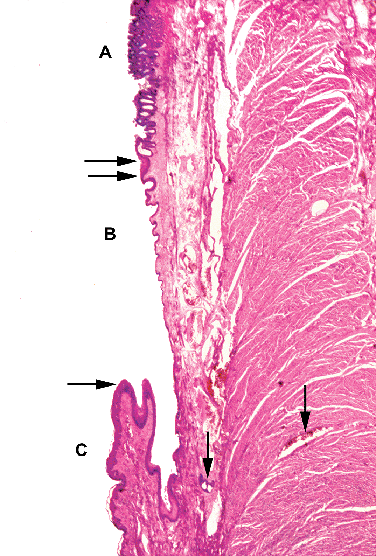 |
Figure 27.8 Longitudinal section of the anal canal showing the anal transitional zone (ATZ) and parts of the neighboring zones. At the upper border of the ATZ, a little island of squamous epithelium can be seen. The ATZ extends down into an anal sinus. The vertical arrows indicate anal glands in the submucosa and internal sphincter (H&E). The double horizontal arrows indicate the upper border of the AZT; the single horizontal arrow, the dentate line. (A, colorectal zone; B, anal transitional zone; C, squamous zone) |
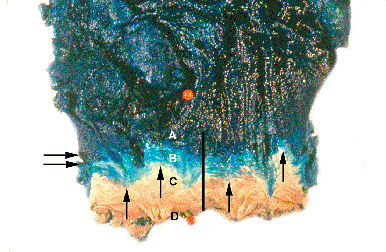 |
Figure 27.9 Surgical specimen of adult anal canal: normal location of anal transitional zone (Alcian green for 15 min).(Black vertical line, extent of the anal canal; single arrows, dentate line; double arrows, upper border of the anal transitional zone; A, colorectal zone; B, anal transitional zone; C, squamous zone; D, perianal skin) |
 |
Figure 27.10 Surgical specimen of adult anal canal: low location of anal transitional zone (Alcian green for 15 min). (Black vertical line, extent of the anal canal; single arrows, dentate line; double arrows, upper border of the anal transitional zone; A, colorectal zone; B, anal transitional zone; C, squamous zone; D, perianal skin) |
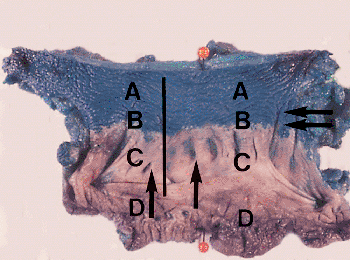 |
Figure 27.11 Surgical specimen of adult anal canal: high location of anal transitional zone, which here is very narrow (Alcian green for 15 min). (Black vertical line, extent of the anal canal; single arrows, dentate line; double arrows, upper border of the anal transitional zone; A, colorectal zone; B, anal transitional zone; C, squamous zone; D, perianal skin) |
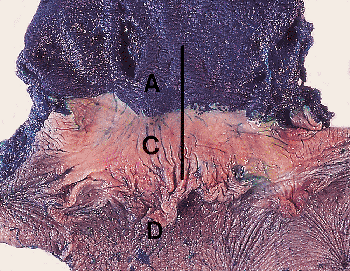 |
Figure 27.12 Surgical specimen of adult anal canal: no anal transitional zone (Alcian green for 15 min). (Black vertical line, extent of the anal canal; single arrows, dentate line; double arrows, upper border of the anal transitional zone; A, colorectal zone; C, squamous zone; D, perianal skin) |
The histologic anal canal is defined by the extent of the special mucosa in this area (i.e., the ATZ and the squamous epithelium down to the perianal skin). Using this definition, microscopic identification of the canal is reasonably easy, and all the special tumors in this area have their origin in the canal. The drawback is that the extent of the anal canal cannot be estimated by the clinicians and that colorectal neoplasias can have their origin inside the histologic anal canal because it also harbors colorectal-type epithelium scattered in the ATZ.
 |
Figure 27.13 Close-up of the anal canal mucosa at the level of the dentate line. The highly irregular outlines of the anal transitional zone (B) contrasts to the heavily stained colorectal-type mucosa above (A) and the unstained squamous zone below (C). The vertical line is for later histologic control of the macroscopic staining (Alcian blue for 15 minutes). |
The surgical anal canal can be identified easily by the clinician and described in the surgical report, thus making communication between surgeon and pathologist easier. The surgical anal canal is also regarded as a functional unit. However, with regard to the mucosal lining, the surgical anal canal most often includes a ring of more or less normal appearing colorectal mucosa at its upper border.
The lack of agreement between macroscopic and microscopic definitions is well known from other areas (i.e., the cervical transformation zone and the esophagogastric junction) and must be accepted. The essential point is that when the clinician describes the location of a process or a biopsy, the position in relation to the DL is the important message. The pathologist will then report what epithelial types are present in the material and, considering the above-mentioned variations, decide whether it is normal.
As the anal canal is described using the definition of the surgical anal canal by the WHO (31), as well as in the tumor-node-metastasis (TNM) system (32), this definition will also be used in the following text.
Anatomy
Mucosal Surface
Following the definition of the surgical anal canal (18), the structure extends from the level of the pelvic floor (pelvic visceral aperture, anorectal ring) to the anal opening (anal verge) (Figure 27.2) and in a living person has an average length of 4.2 cm (37). Histologically, the anal canal extends from the upper to the lower border of the internal anal sphincter and has, on formalin-fixed specimens, an average length of 3 cm (16). This slight difference in definitions and measurements must be accepted because the curved appearance of the anal verge cannot be evaluated histologically and because loss of tonus and the fixation procedures may influence the appearance of the specimens.
The anal lumen often forms a more or less triradiate slit when seen at anoscopy. The stem of the Y so formed approaches the midline posteriorly, and the arms embrace a pad of tissue anteriorly. Thus, three folds are seen, named the anal cushions (38). According to some investigators, the Y is asymmetric and usually embraces a pad of tissue to the right anteriorly (38,39). The anal cushions are present already in fetal life. In an opened surgical specimen from adults, these cushions are often inconspicuous.
The surface relief of the anal canal varies with age. The characteristic relief described in all anatomy textbooks is
P.670
most distinct in children (Figure 27.4). Here the mucosa shows six to ten vertical mucosal folds (the anal columns) that extend from a little below the middle of the anal canal and gradually disappear near the upper end. The anal columns are connected at their bases by small semilunar valves, which occasionally take the form of small papillae. Small pockets, the anal sinuses or crypts, are found behind the valves.
In adults (Figures 27.5, 27.9,27.10,27.11,27.12), the mucosa often shows less pronounced valves and columns and may exhibit a smooth surface with or without scattered anal sinuses and papillae (16).
The three epithelial zones are faintly visible to the naked eye on unstained, formalin-fixed specimens (Figure 27.5). The upper third shows the same relief as the mucosa of the rectum above. The area immediately above the anal valves and sinuses usually appears more smooth and gray-blue. This is the ATZ. Distal to the sinuses, the squamous epithelium appears as a smooth gray-brown area (Stroud's pecten). At the lower border of the anal canal, the dull, wrinkled perianal skin with hair follicles is obvious.
Musculature
The exact arrangement of the anal musculature is still a subject of debate, and new information is still being added using anal endosonography, magnetic resonance imaging, and manometry (40,41). The muscles here are described from the inside out (Figure 27.6).
Musculus Submucosae Ani
The musculus submucosae ani, originally described by Treitz (42), also have been called musculus sustentator tunicae mucosae, musculus mucosus ani, and musculus canalis ani (43). They consist of fibers from the intersphincteric longitudinal muscle, which pass through the internal sphincter, and from the internal sphincter itself. In the submucosa, they form a network around the vascular plexus (Figure 27.14) and are sometimes connected to the muscularis mucosae upward. Caudally, they rejoin the muscles from which they came. Some fibers fan out in the perianal skin, where they may join fibers from the corrugator cutis ani muscle (38,43).
Internal Anal Sphincter
The internal anal sphincter is a continuation of the circular muscle coat of the rectum but is considerably thicker. In histologic sections it measures 5 to 8 mm in thickness and ends 5 to 19 mm (average: 11.4) below the DL (16). Using anal endosonography, the thickness is maximally 4 to 5 mm (41). The muscle receives sympathetic (motor) fibers and parasympathetic (inhibitory) fibers from the inferior hypogastric plexus. In contrast to the adjacent rectum, the internal sphincter contains no enkephalin-immunoreactive fibers, few substance P reactive fibers, but moderate numbers of fibers reactive for neuropeptide Y and vasoactive intestinal peptide (44). Collagen fiber deposition increases with age (45) and is higher in patients with neurogenic fecal incontinence (46). Pelvic irradiation may result in increased fibrosis and nerve density (47).
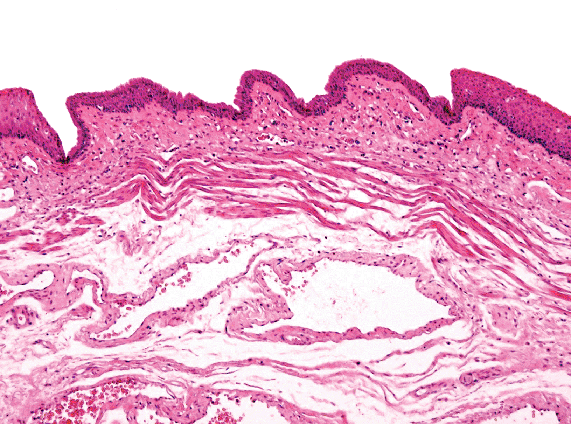 |
Figure 27.14 Anal transitional zone with columnar surface cells (central) and squamous epithelium (left and right). Vascular spaces located below fibers from the muscularis mucosae (H&E). |
Intersphincteric Longitudinal Muscle
The intersphincteric longitudinal muscle is situated between the internal and external sphincters (Figure 27.6). Its thickness varies, and its exact function is unknown (40,48). It contains unstriped fibers from the longitudinal muscle coat of the rectum and striped fibers from the levator ani muscles. At the lower end of the internal sphincter, it breaks up into a number of septae, which diverge fanwise through the subcutaneous part of the external sphincter to end in the corium, thus forming the characteristic corrugation of the perianal skin. These bands are, therefore, referred to as the corrugator cutis ani muscle.
External Sphincter
The striated anal sphincter is traditionally described as a circular muscle, which can be divided into a deep part and a superficial part that surround the internal sphincter and a subcutaneous part below these muscles (Figure 27.6). Most investigators have been unable to find a clear separation between these three parts (40). The puborectalis muscle is situated above the external sphincter. There are two prevailing theories about the arrangement of these muscles.
Shafik (49) has described three U-shaped loops, with their convexity directed backward, forward, and backward,
P.671
respectively. The top loop comprises the deep part and the puborectalis muscle, which is attached to the lower part of the symphysis; the intermediate loop is formed by the superficial part and is attached by a fibrous tendon to the dorsal part of the tip of the coccyx; the base loop is formed by the subcutaneous part, which is attached anteriorly to the perianal skin and is split from the longitudinal muscle by the above-mentioned fibers. Oh and Kark (50) described a double-loop theory according to which the puborectalis is directed anteriorly and most of the external sphincter posteriorly. This is in better accordance with recent endosonographical studies (40,41).
The superficial and subcutaneous parts differ from normal striated musculature. They consist of relatively small muscle fibers, in the adult predominantly of the slow switch type (type 1), separated by delicate strands of connective tissue (51,52).
Blood Supply
The arterial supply to the anal canal is considerably greater than would be necessary for metabolism alone. Branches from the superior rectal artery reach the ATZ in nearly all cases, but the middle and inferior rectal arteries often also make substantial contributions (38).
The terminal branches of the arteries split up into small tortuous vessels, some of which form tiny arteriovenous anastomoses with the submucosal venous plexus. This plexus consists of small convoluted vessels with discrete dilatations, which may be fusiform, saccular, or serpentine. Connective tissue fibers and fibers from the musculus submucosae ani are situated between the vessels, thus anchoring them to the internal sphincter. The picture is more complex above the DL, whereas the dilatations are fewer and often larger below it. The drainage is mainly cranial to the superior rectal vein, but branches of the superior, middle, and inferior veins communicate freely below as well as through the internal sphincter (38).
Some investigators have described so-called anal glomeruli, in which groups of small convoluted vessels were surrounded by connective tissue, which separated them from the surrounding loose tissue (Figure 27.15). Such structures probably represent thrombosed vessels with recanalization. The whole system has been referred to as the corpus cavernosum recti (although it is situated in the anal canal) and is more pronounced in the areas corresponding to the anal cushions (39) (Figure 27.16).
Hemorrhoids
According to this new understanding of anal vasculature, hemorrhoids or hemorrhoidal disease should be defined as enlargement or prolapse of the anal cushions, in some cases followed by bleeding and thrombosis (53,54,55). However, it is still debated whether the term hemorrhoid or hemorrhoidal tissue also should be used to describe the normal anatomical structure or asymptomatic enlargement of the anal cushions (56,57).
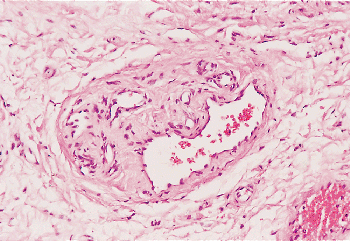 |
Figure 27.15 So-called anal glomerulus (H&E). |
The pathogenesis of symptomatic hemorrhoids has been debated for many years, and a low-fiber diet, constipation and prolonged straining, abnormal anal pressure, hypertension in the anal cushions, and hereditary and hormonal factors may be involved. Others have found hemorrhoids associated with diarrhea and obesity but not with age, constipation, cirrhosis, or varicose veins (58).
Deterioration of the supporting and anchoring connective tissue and degenerative changes of the collagen fibers, together with replacement of muscle tissue by collagen, which begins in the third decade, make the structures less stable. The result is venous stasis and dilatation and sliding down of the anal cushions, sometimes followed by prolapse. Damage to the surface may lead to bleeding of arteriolar origin. Inflammation and focal pressure may be
P.672
followed by further stasis, edema, thrombosis, and neovascularization (59).
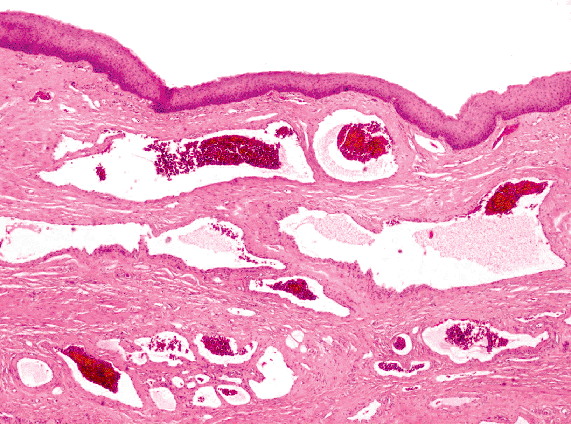 |
Figure 27.16 Longitudinal section through the anal transitional zone showing an anal cushion (H&E). |
This new understanding harmonizes well with the histologic picture of tissue from hemorrhoidectomies. The specimens most often consist of connective tissue stroma with scattered fibers of smooth muscle. The stroma may contain many blood vessels and larger vascular spaces that vary in size and configuration and are often less than 2 to 3 mm in diameter. Inflammatory changes and signs of recent or past thrombosis may be present, as may stromal fibromuscular hyperplasia and elastic fiber proliferation. In some cases the removed hemorrhoid more resembles a fibroepithelial polyp (54). Neuronal hyperplasia is common (60). The surface lining depends on the degree of descent of the cushion and of course the extent of the surgical excision. It therefore may show colorectal, ATZ, or squamous epithelium, as well as perianal skin. The mucosa may show inflammatory reaction or frank erosion or may be the site of regenerative, metaplastic, or keratotic reactions due to recurrent or permanent prolapse. The so-called fibrous anal polyp is assumed to represent an end stage of a prolapsed cushion (61).
Other Vascular Changes
There are a few differential diagnoses to chronic hemorrhoidal disease. Perianal thrombosis, formerly referred to as perianal hematoma, is an acute dark hard lesion arising under the squamous zone of the anal canal or the perianal skin. It represents a thrombus lying in the larger venous dilatations (61,62). Rectal varices are a result of portal hypertension and represent dilated submucosal veins formed when the communicating veins that connect the superior with the middle and inferior hemorrhoidal veins become enlarged. They extend above the level of hemorrhoids and occasionally downward to reach the buttock, perineum, or upper thigh (63,64). Diffuse cavernous hemangioma of the rectosigmoid is a vascular malformation consisting of vascular channels of variable size and thickness, which may involve the whole bowel wall and mesentery or perirectal tissue and may extend down to the DL (65). Recently, two cases of Dieulafoy's lesion in the anal canal have been described (66).
The vast majority of anal fissures occur in the posterior midline. A variant of the course of the inferior rectal artery has been blamed for a reduced perfusion of the posterior commissure and thereby of significance in the pathogenesis (67). Using Doppler laser flow cytometry, it has been shown that the blood flow in the posterior quadrant of the anal canal and perianal skin is significantly lower than in the anterior left and right quadrant and that the higher the anal pressure, the lower the perfusion (68). In addition, histologic studies have shown a lesser arteriolar density in the posterior quadrant throughout the anal canal (69). These observations have led to the hypothesis that anal fissures are ischemic ulcers.
Nerves
Ganglion cells in the rectum are found in three separate plexuses: the superficial and deep submucous and the myenteric. In the anal canal, ganglion cells belonging to these plexuses are absent or sparse in the first centimeter above the DL (70). The diagnosis of ultrashort Hirschsprung's disease can be made by finding increased acetylcholinesterase reaction in muscularis mucosae and submucosa immediately above the DL (71). The density of interstitial cells of Cajal is significantly lower in the internal sphincter than in the circular muscle layer of the rectum (72).
The sensory innervation (73) of the lower part of the anal canal is accomplished by the inferior rectal nerves. The lining contains free nerve endings as well as organized endings (Meissner's corpuscles, Krause's end bulbs, Golgi-Mazzoni bodies, and genital corpuscles). It is sensitive to touch, pain, heat, and cold.
Sensitivity also can be demonstrated just above the DL in the ATZ, where the same endings can be found just above the anal valves. Thus, pain occasionally can be felt from injections given just above the DL. The ATZ is well supplied with intraepithelial nerve fibers and endings (74). Both types of nerve endings cease abruptly at the transition to the colorectal zone, where only a poorly defined dull sensation is present. However, discrimination seems not to be impaired by excision of the ATZ after restorative proctocolectomy (75).
Patients with hemorrhoids have a mild anal sensory deficit, probably due to the mucosal descent (76). Surgical specimens of hemorrhoids and their end stage, the fibrous polyp, may show proliferation of peripheral nerves without increased terminal density (60) (Figure 27.17).
 |
Figure 27.17 Neuromatous hyperplasia in the anal canal (S-100 protein). |
P.673
Lymphatics
Lymphoid follicles are present in the anal canal from the DL and upward in approximately the same number as in the rectum (about 25/cm2) (77).
The lower part of the anal canal (below the DL) and the perianal skin are drained to the superficial inguinal nodes. The drainage of the upper part is more complex, and varying results have been obtained from injection studies. Most investigators agree that an indirect or intramural system connects lymphatics in the anal canal to the lymphatic plexuses of the rectum (78). Other more direct lymphatics follow the inferior or medial rectal vessels to end in the hypogastric, obturator, and internal iliac nodes, or they follow the superior rectal vessels to end in nodes in the sigmoid mesocolon and near the origin of the inferior mesenteric artery. Occasional connections also have been demonstrated to the common iliac, middle and lateral sacral, lower gluteal, external iliac, and deep inguinal nodes (79).
Lymphatic metastases from carcinoma of the anal canal are most often found in the inguinal, femoral, pararectal, and iliac nodes, and eventually in the mesenteric or para-aortical nodes. Hematogenous metastases are most often located in the liver and lungs (31,36). Studies on sentinel nodes in anal cancer are ongoing (80).
Histology
Colorectal Zone
The mucosa of the upper, colorectal zone is a continuation of the rectal mucosa, and no line of demarcation marks the transition to the anal canal. However, some shortening and irregularity of the crypts often are found in the area closest to the ATZ (Figure 27.18).
Anal Transitional Zone and Anal Glands
As stated above, the upper border of the ATZ is defined by the appearance of other epithelial types. In one-third of cases, the upper part of the ATZ consists of a small rim of mature squamous epithelium (Figures 27.8, 27.18) (16). Many epithelial variants can be found in the ATZ, the most prominent being the so-called ATZ epithelium.
The term ATZ epithelium (81) is not generally accepted but can be used until an exact classification is established. It consists of four to nine cell layers. The basal cells are small, and their nuclei are arranged perpendicular to the basement membrane. The surface cells can be columnar (Figure 27.19), cuboidal or polygonal (Figure 27.20), or flattened (Figure 27.21). Small areas can show umbrella-shaped surface cells and more distinct cell borders (Figure 27.22). Other epithelial types are often present in the ATZ. Small areas of mature squamous epithelium may be present, especially at the upper border. Scattered crypts of colorectal type and small areas of simple columnar epithelium also may be found.
 |
Figure 27.18 Transition between the colorectal zone of the anal canal and the anal transitional zone. Short, slightly irregular crypts. Muscularis mucosae still present (H&E). |
The anal (intramuscular) glands open in the ATZ (Figure 27.8). These glands seem to be present in all anal canals and the median number is six, with a range of three to ten. Four of five are only present in the submucosa, but the rest extend into the internal sphincter and a few percent reach the intersphincteric space or even penetrate the external sphincter (82,83). The epithelial lining and mucin production are similar to the ATZ epithelium (84), and endocrine cells are occasionally present (85). A characteristic feature is the presence of intraepithelial microcysts and occasionally goblet cell metaplasia (Figure 27.23). The epithelium is surrounded by one or two cell layers of myoepithelial cells that stain positive for smooth muscle actin (83). The glands are often surrounded by groups of lymphocytes. It is
P.674
believed that the anal glands may take part in the formation of fistulas. Cysts are usually due to trauma and inflammation. Well-documented cases of anal gland carcinoma are rare (84,86).
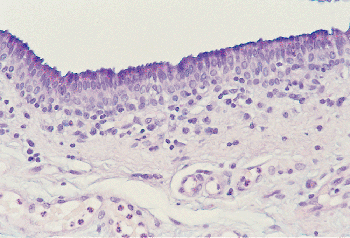 |
Figure 27.19 Anal transitional zone (ATZ): ATZ epithelium with columnar surface cells and scanty mucin production [Alcian blue pH 2.7, periodic acid-Schiff (PAS)]. |
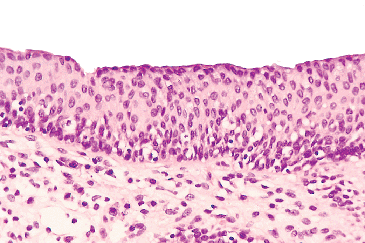 |
Figure 27.20 Anal transitional zone: ATZ epithelium with cuboidal or polygonal surface cells (H&E). |
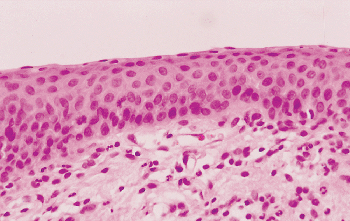 |
Figure 27.21 Anal transitional zone: ATZ epithelium with flattened surface cells and resemblance to squamous epithelium (H&E). |
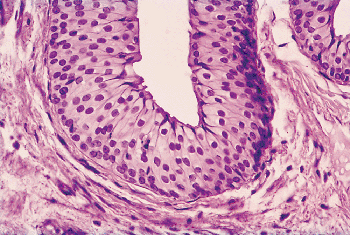 |
Figure 27.22 Anal transitional zone: ATZ epithelium with umbrella-shaped surface cells resembling urothelium. The surface cells are small (H&E). |
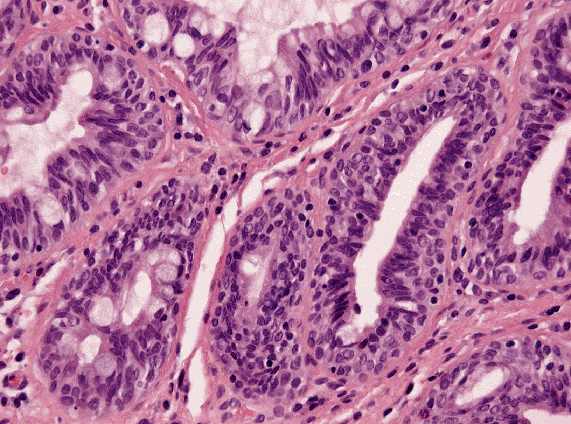 |
Figure 27.23 Anal gland in the submucosa of the anal transitional zone (ATZ). Epithelium is as in ATZ with scattered goblet cells (H&E). |
Squamous Zone
The transition to uninterrupted squamous epithelium usually takes place at the level of the DL. The squamous epithelium is unkeratinized with short or no papillae. Melanocytes increase in number as the perianal skin is approached, and the epithelium contains dendritic (Langerhans) cells (60) (Figure 27.24), T lymphocytes (87), and Merkel cells (88) (Figure 27.25). These cells also may be present in squamous metaplasia covering hemorrhoids. The number of dendritic cells is increased in cases of condylomata but decreased in case of concomitant HIV infection (89). Glands or skin appendages are never present in the squamous zone.
Perianal Skin and Glands
Keratinization becomes apparent at the lower end of the anal canal, and the squamous zone gradually merges into the perianal skin with sweat glands, hairs, and sebaceous glands. A characteristic finding is the presence of apocrine glands in the subcutaneous tissue (Figure 27.26). An additional type of glands, the so-called anogenital sweat glands, are lined by a simple columnar epithelium with cytoplasmic snouts protruding into the lumen and resting on a layer of flat myoepithelium (90) (Figure 27.27). These glands are probably the point of origin for papillary hidradenoma (91).
Lamina Propria and Muscularis Mucosae
The lamina propria consists of loose connective tissue which in the squamous zone often contains a variable number of
P.675
mast cells and small mononuclear or multinucleated CD34+ stromal cells probably of fibroblastic origin (Figure 27.28). It has been suggested that these cells are involved in the formation of fibroepithelial polyps (92,93,94). Fibroepithelial polyps occasionally also show neuronal hyperplasia and hyaline vascular changes (60,94).
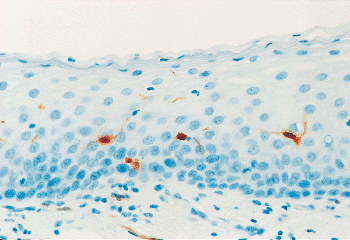 |
Figure 27.24 Langerhans cells in the squamous zone (S-100). |
The well-defined muscularis mucosae of the rectum continue in the colorectal zone of the anal canal (Figure 27.18) and can be found in the upper part af the ATZ (Figure 27.14). Fibers extending up between colorectal crypts indicate mucosal prolapse, and most fibroepithelial polyps also contain fibers from the muscularis mucosae (92,94).
Special Techniques
Mucin Histochemistry
The columnar variant of the ATZ epithelium produces small amounts of a mixture of sulfomucins and sialomucins,
P.676
characterized by a scarcity of O-acylated sialic acids, in contrast to the colorectal type mucosa above (95).
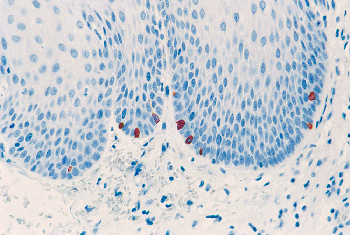 |
Figure 27.25 Merkel cells in the squamous zone (CK20). |
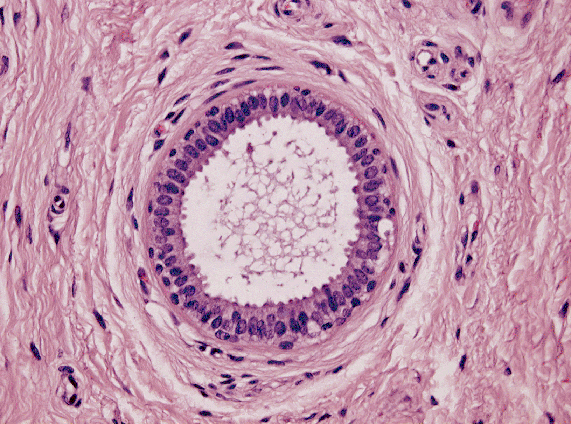 |
Figure 27.26 Apocrine gland (H&E). |
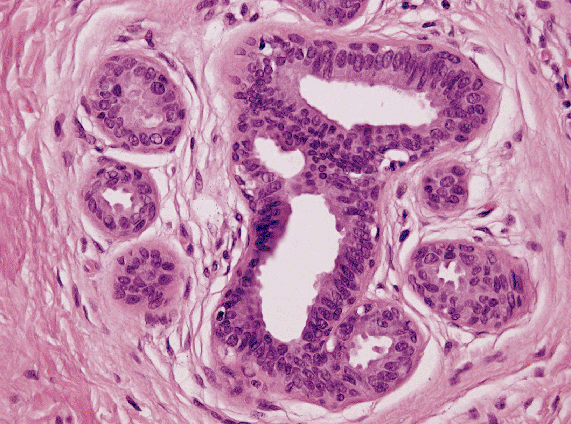 |
Figure 27.27 Anogenital sweat gland (H&E). |
 |
Figure 27.28 Stromal cells (CD34). |
Cytokeratins
The keratin expression of the various epithelial types in the anal canal is complex (96). Briefly, the typical reactions in colorectal type epithelium are CK20+/CK7 and in ATZ epithelium and anal glands CK7+/CK20 , and this pattern is also found in tumors originating in the respective epithelia (86,97,98).
The reaction for CK7 varies in the ATZ epithelium, sometimes being very strong throughout all layers, sometimes being absent in the basal layer or the whole epithelium (Figure 27.29). In addition, the ATZ and anal glands are usually positive for cytokeratins 4, 8, 13, 16, 17, 18, and 19. The coexpression of CK4 and CK13 has also been observed in the transitional epithelium of the urinary bladder.
Proliferation Markers
The proliferative marker MIB-1 for Ki-67 is positive in a layer of cells immediately above the basal layer and may be quite pronounced, especially in cases of hemorrhoids and prolapse (Figure 27.30). However, the reaction still differs from that seen in anal intraepithelial neoplasia (Figure 27.31).
Hormone Receptors
Androgen, estrogen, and, to a lesser degree, progesterone receptors have been demonstrated in the squamous epithelium, as well as in the underlying stroma and in the smooth muscle cells of the internal sphincter in most individuals and at all ages, indicating that the organ is a target for sex steroid hormones (99). The anogenital sweat glands and the corresponding papillary hidradenoma show positive reaction for estrogen and progesterone receptors, in contrast to conventional sweat glands (91) (Figure 27.32).
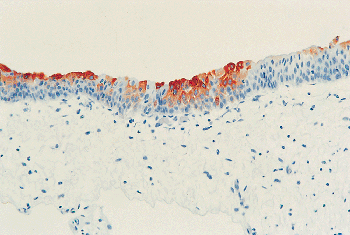 |
Figure 27.29 ATZ epithelium with varying cytokeratin expression (CK7). |
 |
Figure 27.30 ATZ epithelium: proliferative activity (MIB-1). |
Neuroendocrine Markers
The characteristic epithelia of the ATZ and anal glands contain a heterogeneous population of endocrine cells (81,85), which all show positive reaction for synaptophysin and chromogranin A (Figure 27.33). The cells have slender processes that approximate the surface and a fine granular cytoplasm. The number varies, and the largest population also reacts for serotonin and pancreastatin, but cells positive for somatostatin, peptide tyrosine tyrosine, glucagon-like peptide 1, calcitonin gene related peptide, protein gene product 9.5, and neurotensin are occasionally present. The pattern is a mixture of products typical for colorectal epithelium and for Merkel cells in the squamous epithelium (88,100).
 |
Figure 27.31 Anal intraepithelial neoplasia (AIN): proliferative activity (MIB-1). |
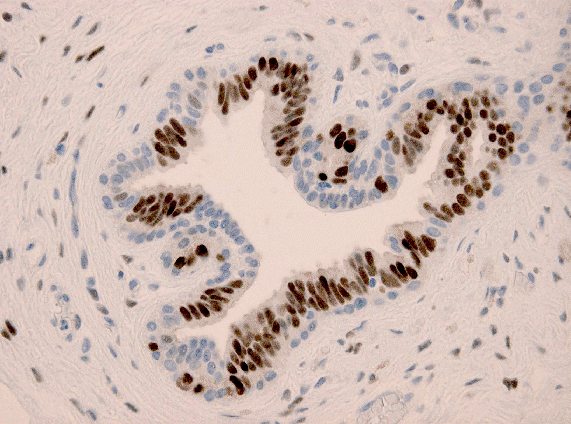 |
Figure 27.32 Anogenital sweat gland (estrogen receptor). |
P.677
Melanin-Containing Cells
A few melanocytes are also occasionally present in the ATZ (85,101,102). These are CK7 /CK20 and positive for S-100 protein, Melan A, and HMB-45 (Figure 27.34). The corresponding malignant melanoma may be amelanotic and positive for polyclonal but not monoclonal carcinoembryonic antigen (CEA) (103).
Flow Cytometric Microscopy and Electron Microscopy
Flow cytometric DNA analyses of the ATZ epithelium have shown a dominating diploid population with a small hyperdiploid peak, resembling the picture of metaplastic epithelium (104). Transmission electron microscopy has not shown asymmetric unit membranes. In scanning electron microscopy, the surface cells show distinct cell borders and short microvilli (Figure 27.35) (81).
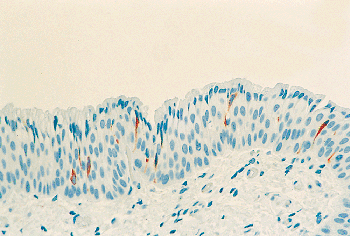 |
Figure 27.33 Anal transitional zone epithelium: endocrine cells (chromogranin). |
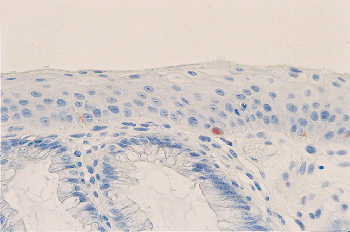 |
Figure 27.34 Anal transitional zone: three melanin-containing cells in the surface epithelium (HMB-45). |
Metaplasia and Heterotopia
Other epithelial types may be present and sometimes indicate pathologic conditions. Occasionally, colorectal-type crypts in the ATZ may contain Paneth's cells (Figure 27.36) or show pyloric metaplasia (Figure 27.37), probably as a result of mucosal damage (as in longstanding colitis). Squamous metaplasia in the ATZ and even in the colorectal zone is seen in cases of prolapse, and keratinization may be present (Figure 27.38).
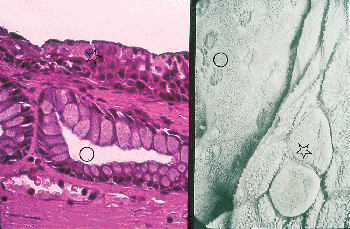 |
Figure 27.35 Anal transitional zone: A. colorectal crypt (open circle) and ATZ epithelium (open star); B. same area in H&E and SEM (original magnification 1500). Reprinted with permission from: Fenger C, Knoth M. The anal transitional zone: a scanning and transmission electron microscopic investigation of the surface epithelum. Ultrastruct Pathol 1981;163 173. |
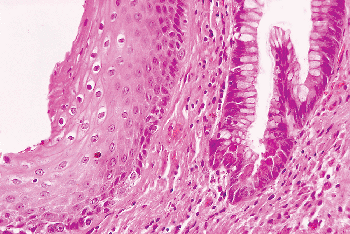 |
Figure 27.36 Anal transitional zone: area with squamous epithelium covering a colorectal-type crypt with Paneth's cell metaplasia (H&E). |
P.678
I have seen a single example of fundic gastric mucosa in the anal canal. Such areas, rarely found in the rectum, are histochemically almost identical to their orthotopic counterpart (105). Probably Helicobacter pylori can turn up in the anal canal as it has done in body-type gastric epithelium in the rectum (106). A unique case has been reported showing ectopic prostatic tissue in the lower anal canal (107).
Viral and Neoplastic Changes
Cytomegalovirus, which occasionally infects the rectum, is rarely seem in the anal canal histiocytes (108). Herpesvirus-induced changes are more commonly found in the squamous epithelium (Figure 27.39), and koilocytotic changes due to human papillomavirus (HPV) can be found as high up as in the ATZ (Figure 27.40).
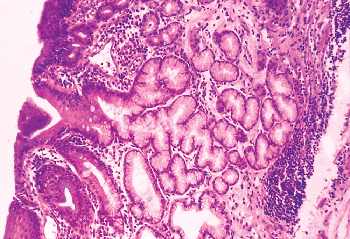 |
Figure 27.37 Anal transitional zone: area with group of pyloric-type glands (H&E). |
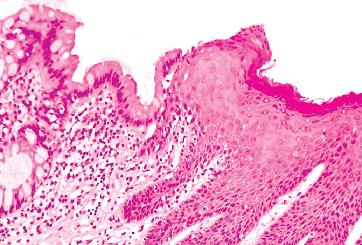 |
Figure 27.38 Anal transitional zone: keratinizing squamous epithelium extending up to the colorectal zone, as is typical in cases of prolapse (H&E). |
Anal intraepithelial neoplasia (AIN), also referred to as dysplasia or anal squamous intraepithelial lesion (ASIL), is not uncommon. It may be present in the squamous zone as well as in the ATZ and in minor surgical as well as in resection specimens (Figures 27.31, 27.41) (109,110). Squamous carcinoma and AIN are particularly common among men who have sex with men, patients with HIV/AIDS, and transplant recipients and in the rare syndromes Wiskott-Aldrich and epidermodysplasia verruciformis, indicating an attenuated immune response is of importance (111). High-risk HPV is found in most lesions, in particular those located high in the anal canal (112). Exact and reproducible grading of AIN is difficult in biopsies, as well as in cytologic specimens (113,114,115). Follow-up studies have shown that many cases of AIN I II will regress but that a considerable number of AIN III will recur, even aften highly active antiviral therapy. There are however only few documented cases of transition to
P.679
squamous carcinoma, and the real risk is unknown (33,116,117).
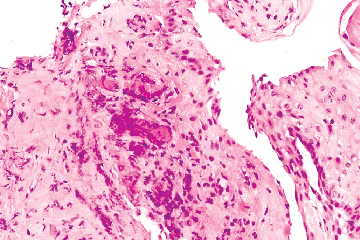 |
Figure 27.39 Herpes-induced epithelial changes in the squamous zone below the dentate line (H&E). |
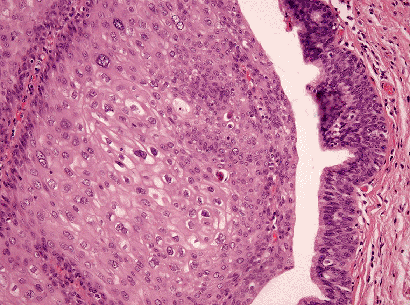 |
Figure 27.40 Anal transitional zone: area with squamous epithelium showing koilocytotic changes. Normal ATZ epithelium to the right (H&E). |
Squamous carcinoma of the anal canal may have different appearances (i.e., basaloid or keratinizing), but there is substantial overlap of the histologic features found in these tumors (112,118), and the reproducibility of the older WHO classification is rather low (119). In the recent WHO classification, it is therefore recommended that the generic term squamous carcinoma be used for these tumors (31). Prognostic markers have not yet been identified (120). A summary of tumors originating in the different zones is listed in Table 27.3.
Table 27.3 Anal Canal Mucosal Zones: Cell Types and Neoplastic Counterparts | ||||||||||||||||||||||||||||||||||||||||
|---|---|---|---|---|---|---|---|---|---|---|---|---|---|---|---|---|---|---|---|---|---|---|---|---|---|---|---|---|---|---|---|---|---|---|---|---|---|---|---|---|
| ||||||||||||||||||||||||||||||||||||||||
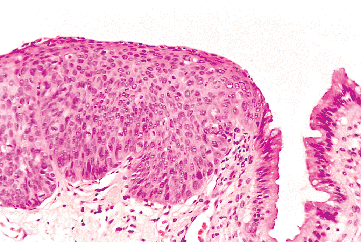 |
Figure 27.41 Anal transitional zone: area with severe dysplasia (AIN III) (H&E). |
Finally, it should be remembered that the anal area is a common site of extramammary Paget's disease and that many of these patients have a synchronous or metachronous malignant tumor. Paget's cells must be distinguished from artifactual clear cells, glycogen-rich cells, koilocytes, and clear cells in pagetoid dyskeratosis, pagetoid Bowen's disease and pagetoid melanoma (121) (Figure 27.42).
P.680
True Paget's cells nearly always show positive reactions for mucin, CEA, and CK7 (Figure 27.43) (122). Primary Paget's is usually positive for gross cystic disease fluid protein and negative for CK20, while the opposite pattern is found in Paget's secondary to colorectal adenocarcinoma (98).
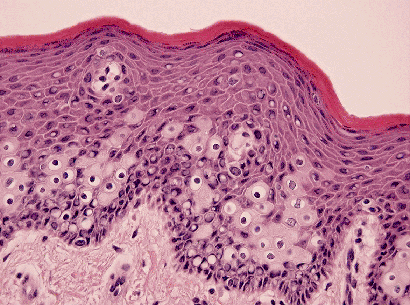 |
Figure 27.42 Squamous zone: clear cells in pagetoid dyskeratosis (H&E). |
Function
The normal function of the rectum and anal canal is the result of a combination of factors, including not only the puborectalis and sphincter muscles, but also stool volume and consistency, rectal storage capacity, sensation, and delivery, as well as cognitive and behavioral influences. The functional disorders, the various techniques for investigation of anorectal dysfunction, and the diagnosis and treatment have been extensively reviewed recently (123,124,125). The significance of the ATZ for normal anal function is still a subject of debate (126).
Table 27.4 Typical Immunohistochemistry of Normal and Neoplastic Anal Canal | ||||||||||||||||||||||||||||||||||||
|---|---|---|---|---|---|---|---|---|---|---|---|---|---|---|---|---|---|---|---|---|---|---|---|---|---|---|---|---|---|---|---|---|---|---|---|---|
| ||||||||||||||||||||||||||||||||||||
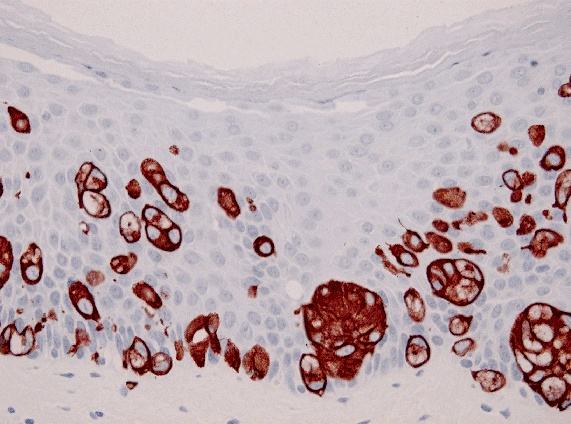 |
Figure 27.43 Squamous zone: Paget's cells (CK7). |
Gender and Aging
There is little information on differences in the anal canal between the two sexes and as a result of aging. The surgical anal canal is a few millimeters shorter in females (4.4 cm
P.681
vs. 4.0 cm in males) (37), and the external sphincter is also shorter, particularly its anterior part (40,41). With aging, the collagen fiber deposition increases in the internal sphincter (45).
The mucosal surface is often more smooth in the elderly, and the papillae may be more pronounced (Figure 27.5). The underlying connective tissue becomes less stable, which may result in descent of the anal cushions and subsequent squamous metaplasia of the ATZ (54). The number of lymphoid follicles does not change with age (77).
Specimen Handling
In minor surgical specimens it is often possible to identify the smooth gray-brown squamous zone from the gray-blue, more glistening anal mucosa. The tissue always should be cut and embedded along the longitudinal axis in order to describe the lesions (i.e., AIN) in relation to the different epithelial zones.
Local excisions should be provided by the surgeon with a suture at the proximal end, pinned up on a plate and sectioned in the same way with special attention to resection lines. Larger surgical specimens are rare nowadays where anal carcinoma most often is treated nonsurgically. They should also be pinned up, and multiple sections may be necessary to find or exclude residual tumor tissue. Information on previous radiation therapy should be provided.
Normally most diagnoses can be established without the use of special stains, but occasionally a panel of immunohistochemical reactions is useful (Table 27.4).
References
1. Fenger C. The anal transitional zone. Acta Pathol Microbiol Immunol Scand Suppl 1987;289:1 42.
2. Parks AG. De haemorrhois. A study in surgical history. Guys Hosp Rep 1955;104:135 156.
3. Braun WO. Untersuchungen ber das Tegument der Anal ffnung [inaugural dissertation]. K nigsberg, Germany: R Leopold; 1901.
4. Glisson F. Tractatus de ventriculo et intestinis. In: Clerici D, Mangeti JJ, eds. Bibliotheca anatomica sive thesaurus. 2nd ed. Vol 1. Geneva: Chou t et Ritter; 1699. (Quoted in Braun, ref. 3.)
5. Morgagni GB. Adversaria anatomica omnia. Advers III, Animadv. VI. Patavii, Italy: Josephus Cominus; 1717:10 11.
6. Heister L. Compendium Anatomicum. 3rd ed. Altorf et Norimbergae; 1727:344.
7. Winsl w JB. Exposition Anatomique de la Structure de Corps Humain. Nouvelle dition, Tome III. Amsterdam: Tourneisen; 1732:346, 351.
8. Robin C, Cadiat A. Sur la structure et les rapports des teguments au niveau de leur jonction dans les regions anale, vulvaire, et du col ut rin. J l'Anat Physiol Pario; 1874;10:589 620.
9. Gay A. Die Circumanaldr sen des Menschen. S K Akad Wiss Wien 1871;43:329 333.
10. Chiari H. ber die nalen Divertikel der Rectumschleimhaut und ihre Beziehung zu den Analisteln. Med Jahrb cher Wien. 1878;8:419 427.
11. Hermann G, Desfosses L. Sur la muquese de la region cloacale du rectum. C R Acad Sci 1880;90:1301 1302.
12. Hilton J. In: Jacobsen WHA, ed. Rest and pain. 3rd ed. London: Bell & Sons; 1880:288.
13. Stroud BB. The anatomy of the anus. Ann Surg 1896;24:1 15.
14. Ewing MR. The white line of Hilton. Proc R Soc Med 1954;47:525 530.
15. Parks AG. Modern concepts of the anatomy of the anorectal region. Postgrad Med J 1958;34:360 366.
16. Fenger C. The anal transitional zone. Location and extent. Acta Pathol Microbiol Scand A 1979;87:379 386.
17. Fenger C, Nielsen K. Stereomicroscopic investigation of the anal canal epithelium. Scand J Gastroenterol 1982;17:571 575.
18. Symington J. The rectum and anus. J Anat Physiol 1888;23:106 115.
19. Buie LA. Practical Proctology. Philadelphia: WB Saunders; 1937:40 50.
20. Tourneux F. Sur le premiers d veloppements du cloaques du tubercule genitale et de l'anus chez l'embryon de mouton. J Anat (Paris) 1888;24:503 517.
21. Retterer E. Sur l'origin et l'evolution de la r gion ano-g nitale des mammif res. J Anat Physiol (Paris) 1890;26:126 210.
22. Nievelstein RA, van der Werff JF, Verbeek FJ, Valk J, Vermeij-Keers C. Normal and abnormal embryonic development of the anorectum in human embryos. Teratology 1998;57:70 78.
23. Rogers DS, Paidas CN, Morreale RF, Hutchins GM. Septation of the anorectal and genitourinary tracts in the human embryo: crucial role of the catenoidal shape of the urorectal sulcus. Teratology 2002;66:144 152.
24. Cuschieri A, EUROCAT Working Group. Descriptive epidemiology of isolated anal anomalies: a survey of 4.6 million births in Europe. Am J Med Genet 2001;103:207 215.
25. Lewin KJ, Riddell RH, Weinstein WM. The anal canal. In: Lewin KJ, Riddell RH, Weinstein WM, eds. Gastrointestinal Pathology and Its Clinical Implications. New York: Igaku-Shoin; 1992:1318 1359.
26. Wendell-Smith CP. Anorectal nomenclature: fundamental terminology. Dis Colon Rectum 2000;43:1349 1358.
27. Federative Committee on Anatomical Terminology. Terminologia Anatomica: International Anatomical Terminology. Stuttgart: Thieme; 1998.
28. Fenger C. The anal transitional zone. A method for macroscopic demonstration. Acta Pathol Microbiol Scand A 1978;86:225 230.
29. Fenoglio-Preiser CM, Noffsinger AE, Stemmermann GN, et al. Gastrointestinal Pathology. An Atlas and Text. 2nd ed. Philadelphia: Lippincott-Raven; 1999.
30. Day DD, Jass JR, Price AB, Shepherd NA, Sloan JM, Talbot IC, Warren BF, Williams GT. Morson and Dawson's Gastrointestinal Pathology. 4th ed. Oxford: Blackwell Science; 2003;643 646.
31. Fenger C, Frisch M, Marti MC, Parc R. Tumours of the anal canal. In: Hamilton SR, Aaltonen LA, eds. World Health Organization Classification of Tumours: Pathology and Genetics of Tumours of the Digestive System. Lyon, France: IARC Press; 2000:145 155.
32. Wittekind C, Greene FL, Hutter RVP, Klimpfinger M, Sobin LH, eds. UICC TNM Atlas. 5th ed. Berlin: Springer; 2005.
33. Fenger C, Nielsen VT. Intraepithelial neoplasia in the anal canal. The appearance and relation to genital neoplasia. Acta Pathol Microbiol Immunol Scand A 1986;94:343 349.
34. Jay N, Berry JM, Hogeboom CJ, Holly EA, Darragh TM, Palefsky JM. Colposcopic appearance of anal squamous intraepithelial lesions: relationship to histopathology. Dis Colon Rectum 1997;40:919 928.
35. Thompson-Fawcett MW, Warren BF, Mortensen NJ. A new look at the anal transitional zone with reference to restorative proctocolectomy and the columnar cuff. Br J Surg 1998;85:1517 1521.
36. Greene FL, Page DL, Fleming ID, et al., eds. AJCC Cancer Staging Manual. 6th ed. New York: Springer; 2002.
37. Nivatvongs S, Stern HS, Fryd DS. The length of the anal canal. Dis Colon Rectum 1981;24:600 601.
38. Thomson WHF. The nature of haemorrhoids. Br J Surg 1975;62:542 552.
39. Stelzner F, Staubesand J, Machleidt H. Das Corpus cavernosum recti die Grundlage der inneren H morrhoiden. Langenbecks Arch Klin Chir 1962;299:302 312.
P.682
40. Sultan AH, Kamm MA, Hudson CN, Nicholls JR, Bartram CI. Endosonography of the anal sphincters: normal anatomy and comparison with manometry. Clin Radiol 1994;49:368 374.
41. Williams AB, Bartram CI, Halligan S, Marshall MM, Nicholls RJ, Kmiot WA. Multiplanar anal endosonography normal anal canal anatomy. Colorectal Dis 2001;3:169 174.
42. Treitz W. ber einen neuen Muskel am Duodenum des Menschen, ber elastische Sehnen, und einige andere anatomische Verh ltnisse. Vierteljahrschrift f r die Praktische Heilkunde 1853;37:113 144.
43. Hansen HH. Die Bedeutung des Musculus canalis ani f r die Kontinenz und anorectale Erkrankungen. Langenbecks Arch Chir 1976;341:23 37.
44. Wattchow DA, Furness JB, Costa M. Distribution and coexistence of peptides in nerve fibers of the external muscle of the human gastrointestinal tract. Gastroenterology 1988;95:32 41.
45. Klosterhalfen B, Offner F, Topf N, Vogel P, Mittermayer C. Sclerosis of the internal anal sphincter a process of aging. Dis Colon Rectum 1990;33:606 609.
46. Speakman CT, Hoyle CH, Kamm MA, et al. Abnormal internal anal sphincter fibrosis and elasticity in fecal incontinence. Dis Colon Rectum 1995;38:407 410.
47. Da Silva GM, Berho M, Wexner SD, et al. Histologic analysis of the irradiated anal sphincter. Dis Colon Rectum 2003;46:1492 1497.
48. Lunniss PJ, Phillips RK. Anatomy and function of the anal longitudinal muscle. Br J Surg 1992;79:882 884.
49. Shafik A. A concept of the anatomy of the anal sphincter mechanism and the physiology of defecation. Dis Colon Rectum 1987;30:970 982.
50. Oh C, Kark AE. Anatomy of the external anal sphincter. Br J Surg 1972;59:717 723.
51. Lierse W, Holschneider AM, Steinfeld J. The relative proportions of type I and type II muscle fibers in the external sphincter ani muscle at different ages and stages of development observations on the development of continence. Eur J Pediatr Surg 1993;3:28 32.
52. Schr der HD, Reske-Nielsen E. Fiber types in the striated urethral and anal sphincters. Acta Neuropathol (Berl) 1983;60:278 282.
53. Johanson JF, Sonnenberg A. Constipation is not a risk factor for hemorrhoids: a case-control study of potential etiological agents. Am J Gastroenterol 1994;89:1981 1986.
54. Kaftan SM, Haboubi NY. Histopathological changes in haemorrhoid associated mucosa and submucosa. Int J Colorectal Dis 1995;10:15 18.
55. Lunniss PJ, Mann CV. Classification of internal haemorrhoids: a discussion paper. Colorect Dis 2004;6:226 232.
56. Haas PA, Haas GP, Schmaltz S, Fox TA Jr. The prevalence of hemorrhoids. Dis Colon Rectum 1983;26:435 439.
57. Haas PA. The prevalence of confusion in the definition of hemorrhoids. Dis Colon Rectum 1992;35:290 291.
58. Johanson JF, Sonnenberg A. Constipation is not a risk factor for hemorrhoids: a case-control study of potential etiological agents. Am J Gastroenterol 1994;89:1981 1986.
59. Chung YC, Hou YC, Pan AC. Endoglin (CD105) expression in the development of haemorrhoids. Eur J Clin Invest 2004;34:107 112.
60. Fenger C, Schr der HD. Neuronal hyperplasia in the anal canal. Histopathology 1990;16:481 485.
61. Thomson H. The anal cushions a fresh concept in diagnosis. Postgrad Med J 1979;55:403 405.
62. Brearley S, Brearley R. Perianal thrombosis. Dis Colon Rectum 1988;31:403 404.
63. Johansen K, Bardin J, Orloff MJ. Massive bleeding from hemorrhoidal varices in portal hypertension. JAMA 1980;244:2084 2085.
64. McCormack TT, Bailey HR, Simms JM, Johnson AG. Rectal varices are not piles. Br J Surg 1984;71:163.
65. Aylward CA, Orangio GR, Lucas GW, Fazio VW. Diffuse cavernous hemangioma of the rectosigmoid CT scan, a new diagnostic modality, and surgical management using sphincter-saving procedures. Report of three cases. Dis Colon Rectum 1988;31:797 802.
66. Azimuddin K, Stasik JJ, Rosen L, Riether RD, Khubchandani IT. Dieulafoy's lesion of the anal canal: a new clinical entity. Report of two cases. Dis Colon Rectum 2000;43:423 426.
67. Klosterhalfen B, Vogel P, Rixen H, Mittermayer C. Topography of the inferior rectal artery: a possible cause of chronic, primary anal fissure. Dis Colon Rectum 1989;32:43 52.
68. Schouten WR, Briel JW, Auwerda JJ. Relationship between anal pressure and anodermal blood flow. The vascular pathogenesis of anal fissures. Dis Colon Rectum 1994;37:664 669.
69. Lund JN, Binch C, McGrath J, Sparrow RA, Scholefield JH. Topographical distribution of blood supply to the anal canal. Br J Surg 1999;86:496 498.
70. Aldridge RT, Campbell PE. Ganglion cell distribution in the normal rectum and anal canal. A basis for the diagnosis of Hirschsprung's disease by anorectal biopsy. J Pediatr Surg 1968;3:475 490.
71. Meier-Ruge WA, Bruder E, Holschneider AM, et al. Diagnosis and therapy of ultrashort Hirschsprung's disease. Eur J Pediatr Surg 2004;14:392 397.
72. Hagger R, Gharaie S, Finlayson C, Kumar D. Distribution of the interstitial cells of Cajal in the human anorectum. J Auton Nerv Syst 1998;73:75 79.
73. Duthie HL, Gairns FW. Sensory nerve-endings and sensation in the anal region of man. Br J Surg 1960;47:585 595.
74. Lassmann G. Histologie und Innervation der analen Ductus und Glandulae. Coloproctology 1983;5:232 235.
75. Keighley MR, Winslet MC, Yoshioka K, Lightwood R. Discrimination is not impaired by excision of the anal transition zone after restorative proctocolectomy. Br J Surg 1987;74:1118 1121.
76. Miller R, Bartolo DC, Roe A, Cervero F, Mortensen NJ. Anal sensation and the continence mechanism. Dis Colon Rectum 1988;31:433 438.
77. Langman JM, Rowland R. Density of lymphoid follicles in the rectum and at the anorectal junction. J Clin Gastroenterol 1992;14:81 84.
78. Blair JB, Holyoke EA, Best RR. A note on the lymphatics of the middle and lower rectum and anus. Anat Rec 1950;108:635 644.
79. Caplan I. The lymphatic vessels of the anal region a study and investigation of about 50 cases. Folia Angiol 1976;24:260 264.
80. Damin DC, Rosito MA, Schwartsmann G. Sentinel node in carcinoma of the anal canal: a review. EJSO 2006;32:247 252.
81. Fenger C, Knoth M. The anal transitional zone: a scanning and transmission electron microscopic investigation of the surface epithelium. Ultrastruct Pathol 1981;2:163 173.
82. McColl I. The comparative anatomy and pathology of anal glands. Arris and Gale lecture delivered at the Royal College of Surgeons of England on 25th February 1965. Ann R Coll Surg Engl 1967;40:36 67.
83. Seow-Choen F, Ho JM. Histoanatomy of anal glands. Dis Colon Rectum 1994;37:1215 1218.
84. Fenger C, Filipe MI. Pathology of the anal glands with special reference to their mucin histochemistry. Acta Pathol Microbiol Scand A 1977;85:273 285.
85. Fenger C, Lyon H. Endocrine cells and melanin-containing cells in the anal canal epithelium. Histochem J 1982;14:631 639.
86. Hobbs CM, Lowry MA, Owen D, Sobin LH. Anal gland carcinoma. Cancer 2001;92:2045 2049.
87. Gervaz E, Dauge-Geffroy MD, Sobhani I, et al. Quantitative analysis of the immune cells in the anal mucosa. Pathol Res Pract. 1995;191:1067 1071.
88. H rsch D, Fink T, G ke B, Arnold R, B chler M, Weihe E. Distribution and chemical phenotypes of neuroendocrine cells in the human anal canal. Regul Pept 1994;54:527 542.
89. Sobhani I, Walker F, Aparicio T, et al. Effect of anal epidermoid cancer-related viruses on the dendritic (Langerhans') cells of the human anal mucosa. Clin Cancer Res 2002;8:2862 2869.
90. van der Putte SCJ. Anogenital sweat glands. Histology and pathology of a gland that may mimic mammary glands. Am J Dermatopathol 1991;13:557 567.
91. Offidani A, Campanati A. Papillary hidradenoma: immunohistochemical analysis of steroid receptor profile with a focus on apocrine differentiation. J Clin Pathol 1999;52:829 832.
92. Groisman GM, Polak-Charcon S. Fibroepithelial polyps of the anus: a histologic, immunohistochemical, and ultrastructural study, including comparison with the normal anal subepithelial layer. Am J Surg Pathol 1998;22:70 76.
P.683
93. Groisman GM, Amar M, Polak-Charcon S. Multinucleated stromal cells of the anal mucosa: a common finding. Histopathology 2000;36:224 228.
94. Sakai Y, Matsukuma S. CD34+ stromal cells and hyalinized vascular changes in the anal fibroepithelial polyps. Histopathology 2002;41:230 235.
95. Fenger C, Filipe MI. Mucin histochemistry of the anal canal epithelium. Studies of normal mucosa and mucosa adjacent to carcinoma. Histochem J 1981;13:921 930.
96. Williams GR, Talbot IC, Northover JM, Leigh IM. Keratin expression in the normal anal canal. Histopathology 1995;26:39 44.
97. Williams GR, Talbot IC, Leigh IM. Keratin expression in anal carcinoma: an immunohistochemical study. Histopathology 1997;30:443 450.
98. Ramalingam P, Hart WR, Goldblum JR. Cytokeratin subset immunostaining in rectal adenocarcinoma and normal anal glands. Implications for the pathogenesis of perianal Paget disease associated with rectal adenocarcinoma. Arch Pathol Lab Med 2001;125:1074 1077.
99. Oettling G, Franz HB. Mapping of androgen, estrogen and progesterone receptors in the anal continence organ. Eur J Obstet Gynecol Reprod Biol 1998;77:211 216.
100. H rsch D, Fink T, B chler M, Weihe E. Regional specificities in the distribution, chemical phenotypes, and coexistence patterns of neuropeptide containing nerve fibres in the human anal canal. J Comp Neurol 1993;335:381 401.
101. Fetissof F, Dubois MP, Assan R, et al. Endocrine cells in the anal canal. Virchows Arch A Pathol Anat Histopathol 1984;404:39 47.
102. Clemmensen OJ, Fenger C. Melanocytes in the anal canal epithelium. Histopathology 1991;18:237 241.
103. Fenger C. CEA reactivity in amelanotic malignant melanoma of the anal canal critical commentary. Pathol Res Pract 1993;189:1077 1078.
104. Fenger C, Bichel P. Flow cytometric DNA analysis of anal canal epithelium and ano-rectal tumours. Acta Pathol Microbiol Immunol Scand A 1981;89:351 355.
105. Carlei F, Pietroletti R, Lomanto D, et al. Heterotopic gastric mucosa of the rectum characterization of endocrine and mucin-producing cells by immunocytochemistry and lectin histochemistry. Report of a case. Dis Colon Rectum 1989;32:159 164.
106. Dye KR, Marshall BJ, Frierson HF Jr, Pambianco DJ, McCallum RW. Campylobacter pylori colonizing heterotopic gastric tissue in the rectum. Am J Clin Pathol 1990;93:144 147.
107. Morgan MB. Ectopic prostatic tissue of the anal canal. J Urol 1992;147:165 166.
108. Blackman E, Vimadalal S, Nash G. Significance of gastrointestinal cytomegalovirus infection in homosexual males. Am J Gastroenterol 1984;79:935 940.
109. Fenger C, Nielsen VT. Dysplastic changes in the anal canal epithelium in minor surgical specimens. Acta Pathol Microbiol Scand A 1981;89:463 465.
110. Fenger C, Nielsen VT. Precancerous changes in the anal canal epithelium in resection specimens. Acta Pathol Microbiol Immunol Scand A 1986;94:63 69.
111. Zbar AP, Fenger C, Efron J, Beer-Gabel M, Wexner SD. The pathology and molecular biology of anal intraepithelial neoplasia: comparisons with cervical and vulvar intraepithelial carcinoma. Int J Colorectal Dis 2002;17:203 215.
112. Frisch M, Fenger C, van den Brule AJ, et al. Variants of squamous cell carcinoma of the anal canal and perianal skin and their relation to human papillomaviruses. Cancer Res 1999;59:753 757.
113. Lytwyn A, Salit IE, Raboud J, Chapman W, Darragh T, Winkler B, Tinmouth J, Mahony JB, Sano M. Interobserver agreement in the interpretation of anal intraepithelial neoplasia. Cancer 2005;103:1447 1456
114. Colquhoun P, Nogueras J, Dipasquale B, Petras R, Wexner SD, Woodhouse S. Interobserver and intraobserver bias exists in the interpretation of anal dysplasia. Dis Colon Rectum 2003;46:1332 1338.
115. Friedlander MA, Stier E, Lin O. Anorectal cytology as a screening tool for anal squamous lesions: cytologic, anoscopic, and histologic correlation. Cancer 2004;102:19 26.
116. Chang GJ, Berry JM, Jay N, Palefsky JM, Welton ML. Surgical treatment of high-grade anal squamous intraepithelial lesions: a prospective study. Dis Colon Rectum 2002;45:453 458.
117. Piketty C, Darragh TM, Heard I, et al. High prevalence of anal squamous intraepithelial lesions in HIV-positive men despite the use of highly active antiretroviral therapy. Sex Transm Dis 2004;31:96 99.
118. Williams GR, Talbot IC. Anal carcinoma a histological review. Histopathology 1994;25:507 516.
119. Fenger C, Frisch M, Jass JJ, Williams GT, Hilden J. Anal cancer subtype reproducibility study. Virchows Arch 2000;436:229 233.
120. Fenger C. Prognostic factors in anal carcinoma. Pathology 2002;34:573 578.
121. Val-Bernal JF, Pinto J. Pagetoid dyskeratosis is a frequent incidental finding in hemorrhoidal disease. Arch Pathol Lab Med 2001;125:1058 1062.
122. Helm KF, Goellner JR, Peters MS. Immunohistochemical stains in extramammary Paget's disease. Am J Dermatopathol 1992;14:402 407.
123. Diamant NE, Kamm MA, Wald A, Whitehead WE. AGA technical review on anorectal testing techniques. Gastroenterology 1999;116:735 760.
124. Cheung O, Wald A. Review article: the management of pelvic floor disorders. Aliment Pharmacol Ther 2004;19:481 495.
125. Billingham RP, Isler JT, Kimmins MH, Nelson JM, Schweitzer J, Murphy MM. The diagnosis and management of common anorectal disorders. Curr Probl Surg 2004;41:586 645.
126. Choi HJ, Saigusa N, Choi JS, et al. How consistent is the anal transitional zone in the double-stapled ileoanal reservoir? Int J Colorectal Dis 2003;18:116 120.